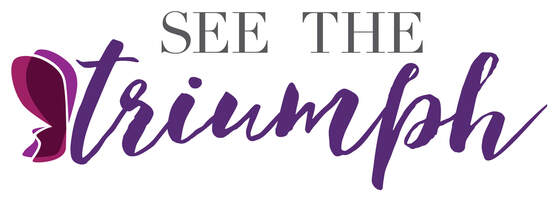|
Note: We first learned about the Speaking Without Words dance video about dating violence in this news report. We love the creativity and vision that went into this work, so we are thrilled to share this guest blog today from Andrew Carroll, the University of South Florida Dance Professor who produced the video. You can view the full-length production here: https://www.dropbox.com/s/cl1q4zuq1t8b7x5/finalspeakingwowords.mp4. Thanks to Andrew for sharing his vision and ideas with us!
By Andrew Carroll, See the Triumph Guest Blogger Assistant Professor of Dance in the School of Theatre and Dance at the University of South Florida As a professor of dance at The University of South Florida, and as one who has spent his career immersed deep within the genre of dance, I have long believed that dance can express where words fail. Indeed, in this landscape of words, texts and new symbols created as a means of communication, movement has and always does exist to illustrate feelings, concepts and nuances on a deeper level of understanding. As an example, I often speak to my students to think of the three words “I love you.” We hear this phrase many times in our lifetime, and perhaps through repetition, the meaning can get blurred or understood only on a surface level through the reoccurring speaking of these same words. Yet, if an individual who truly loves you looks silently into your eyes, and simply reaches out to touch your cheek, the “feeling” of love or caring can be felt more deeply with this gesture of movement, than merely speaking the words. To this end, I was quoted in our USF Arts Calendar as stating that I believed art and/or dance exists where words fail, and only feeling exists. I have held this sentiment both as a performer as a soloist with The Pennsylvania Ballet Company, and now as a professor at USF’s School of Theatre and Dance. My research in the investigation of using dance via the vehicle of a dance music video to communicate stems from this belief. Specifically, my creative research agenda has been to develop a new language using dance in the architecture of social awareness and education. This agenda had its beginnings in a commission I received from The Florida Department of Health, who were interested in a new way to educate their cleaning staffs in proper protocols of C-Diff elimination (a spore that is present in hospital settings, and which is responsible for many illnesses). The FDOH was interested in a dance music video as the means to disseminate this information for several reasons: it was innovative, it had the chance to engage viewers through its use of a popular medium, and lastly, because dance was to be the “language,” it could be understood by any viewer. The FDOH research project was accomplished in 2011, which then led to two more commissions from this organization. Subsequently I began to envision that this medium of a dance music video could be very effective for the school age demographic, as dance videos occupy a niche of entertainment for this group. Therefore, advocacy, awareness and education of social issues might be illustrated valuably if implanted and conveyed through this same format. With this in mind, I applied for a grant in 2011 to produce a new video, but geared towards the issue of Bullying. The Bullying project video was produced in 2012 and surpassed my expectations as to the sheer volume of organizations world-wide who adopted it for use in their respective bullying programs. The success of the Bullying video inspired me to write a new grant in 2013, this time to produce a similar video, but geared towards Dating Violence. I was awarded the funding, and The Dating Violence, Recognizing Warning Signs video project began. The project was completed in August 2013, and by the end of 2013, it has been requested by organizations in Germany, Albania, Armenia, Greece, Belgium, Northern Ireland, Venezuela, Costa Rica as well as the Centers for Disease Control (The CDC) in Atlanta among others. Additionally, these two videos became feature stories on ABC, CBS and Fox National newscasts. As with the Bullying Video, I was fortunate to work with a professional crew of dancers who I handpicked as having the potential to carry off the required dance material in addition to the acting skills needed to portray the issues. The Dating Violence cast approached the work professionally, with the utmost respect for the topic issue. The process was hardest on the male lead who was asked to portray the role of the abuser. The act of aggression was not in his nature, thus he had to dig deep into his dance and acting skills to portray a character that was foreign to him. The rest of the cast, and specifically the female lead, worked diligently with me to experiment with movement phrases that best aligned with the concepts of an unhealthy relationship that I identified through research with the Love and Respect and 2in2u organizations who advocate on behalf of dating violence. Judy Chiasson, of The Office of The Chief of Staff for the entire Los Angeles Unified Public School System who adopted both videos, wrote in an email to me: “The use of dance as dialogue is especially useful as an educational tool for several reasons. Youth are so tired of having adults lecture at them. They get so much more out of a dance video than they ever get out of an adult lecturing. Many of our students express themselves with dance, so this is a media that resonates with them. They respond well to role models who are just a little older than they. So having college-aged dancers is a valuable. The absence of spoken dialogue allows them to draw upon their own experiences to "write" a dialogue that is personally meaningful in the language that they speak. We have 200 languages spoken in the District. Your dances represented some harsh situations that would be too disturbing to be viewed explicitly. I am thinking of your dating violence video. It was very sensitive that the acts of kindness were acted out, but the acts of violence were danced. For our students who are exposed to regularly exposed to violence, the dance expression made it safe to witness. I also like that your pieces all build resiliency and heroism. I will not show any bullying or dating violence piece that does show a positive resolution. Too often, people try to teach children by traumatizing them. There is a wealth of films, documentaries, YouTube videos, and PSAs that show horrific scenes, in a scared straight kind of tactic. I never show such pieces to our students. Your pieces are all positive and give hope and tools. Most of the materials that get marketed are missing those critical elements. “ I would like anyone who views either of these videos to not only take away messages that are imbedded within their constructs, but to also embody the experiences displayed to better understand the concepts on a deeper, physical level. It is my belief that the use of dance and movement can facilitate this process. I also believe that by using strong visual images, students can engage more in the process of learning about the subjects portrayed. This idea, coupled with the notion of the physical embodiment of feelings and senses displayed through dance can supply more investment in the process of awareness and education. This in turn can perhaps lead to a more fertile environment for discussions and dialogues pertaining to bullying and dating violence. Comments are closed.
|
Archives
July 2024
CategoriesAll About Intimate Partner Violence About Intimate Partner Violence Advocacy Ambassadors Children Churches College Campuses Cultural Issues Domestic Violence Awareness Month Financial Recovery How To Help A Friend Human Rights Human-rights Immigrants International Media Overcoming Past Abuse Overcoming-past-abuse Parenting Prevention Resources For Survivors Safe Relationships Following Abuse Schools Selfcare Self-care Sexual Assault Sexuality Social Justice Social-justice Stigma Supporting Survivors Survivor Quotes Survivor-quotes Survivor Stories Teen Dating Violence Trafficking Transformative-approaches |
Search by typing & pressing enter


 RSS Feed
RSS Feed